Feb 26 2019
Prior studies on the two-dimensional (2D) relative of graphite—graphene—have enabled scientists at The University of Manchester to unravel surprising phenomena occurring in this material.
 Image credit: The University of Manchester
Image credit: The University of Manchester
The team guided by Dr Artem Mishchenko, Prof. Volodya Fal’ko, and Prof. Sir Andre Geim discovered the quantum Hall effect (QHE) in bulk graphite, which is a layered crystal composed of stacked graphene layers. This is an unforeseen result as the quantum Hall effect is achievable only in two-dimensional materials where there is limited movement of electrons’ motion. In addition, they have discovered that the material behaves differently based on whether it consists of odd or even number of graphene layers—even if the number of layers in the crystal goes beyond hundreds. The research is a significant stride in the understanding of the basic properties of graphite, which have often been misinterpreted.
For decades graphite was used by researchers as a kind of ‘philosopher’s stone’ that can deliver all probable and improbable phenomena including room-temperature superconductivity. Our work shows what is, in principle, possible in this material, at least when it is in its purest form.
Prof. Sir Andre Geim, The University of Manchester
In the study, reported in Nature Physics, Mishchenko and colleagues investigated devices made from cleaved graphite crystals, which basically has no flaws. The scientists conserved the high quality of the material by enclosing it in hexagonal boron nitride, another high-quality 2D layered material. Due to this, almost perfect samples of thin graphite were able to measure electron transport in this material.
The measurements were quite simple. We passed a small current along the device, applied strong magnetic field and then measured voltages generated along and across the device to extract longitudinal resistivity and Hall resistance.
Dr Jun Yin, Study First Author, The University of Manchester
We were quite surprised when we saw the quantum Hall effect accompanied by zero longitudinal resistivity in our samples. These are thick enough to behave just as a normal bulk semimetal in which QHE should be strictly forbidden.
Prof. Volodya Fal’ko, The University of Manchester
Also, the theory exploration was led by Prof Fal’ko.
According to the investigators, the QHE appears when the applied magnetic field makes the electrons in graphite to travel “in a reduced dimension,” with conductivity only permitted in one direction. Therefore, in adequately thin samples, this one-dimensional motion can become quantized due to the formation of standing electron waves. The material changes from being a 3D electron system to a 0D one, with distinct energy levels in a magnetic field.
Another huge unexpected finding is that this QHE is extremely sensitive to even/odd number of graphene layers. The electrons in graphite are analogous to those in graphene and are found in two “flavors” (known as valleys). The standing waves generated from electrons of two different flavors rest on even-numbered—or odd-numbered—layers in graphite. The films with even number of layers have the same number of even and odd layers, thus the energies of the standing waves of different flavors correspond.
This is not the case with films having odd numbers of layers since the number of even and odd layers is not the same due to the presence of an additional odd layer. This leads to the shifting of energy levels of the standing waves of different flavors with regard to each other and implies that these samples have small QHE energy gaps. The phenomenon even exists for graphite which is hundreds of layers thick.
The surprising findings did not end there: the scientists also noticed the fractional QHE in thin graphite at temperatures less than 0.5 K. The fractional QHE is caused by strong interactions between electrons. These interactions, which can usually result in key collective phenomena like magnetism, superfluidity, and superconductivity, render the charge carriers act as particles having a charge that is a fraction of that of an electron.
Most of the results we have observed can be explained using a simple single-electron model but seeing the fractional QHE tells us that the picture is not so simple. There are plenty of electron-electron interactions in our graphite samples at high magnetic fields and low temperatures, which shows that many-body physics is important in this material.
Dr Artem Mishchenko, The University of Manchester
For the past 15 years, Graphene has been gaining attention because of its several superlative properties, and graphite was pushed back a little due to its one-layer-thick offspring. Mishchenko adds, “We have now come back to this old material. Knowledge gained from graphene research, improved experimental techniques (such as van der Waals assembly technology) and a better theoretical understanding (again from graphene physics), has already allowed us to discover this novel type of the QHE in graphite devices we made.”
“Our work is a new stepping stone to further studies on this material, including many-body physics, like density waves, excitonic condensation or Wigner crystallization.”
The Manchester researchers state that they currently aim to investigate all those phenomena and theoretical predictions using the information that their thin graphite samples are as ideal as materials can be.